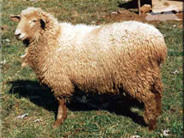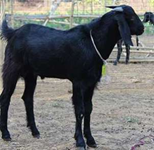Biology > Animal Husbandry > Sheep, Goat, and Pig Farming
Meat yielding animals include sheep, goats, and pigs.
Sheep:
Sheep is the second largest species reared by mankind and it provides wool, meat, milk, and hides. Their droppings form good manure. It provides a dependable source of income to the shepherds through the sale of wool and animals. They play an important role in the livelihood of a large percentage of small and marginal farmers and landless labourers engaged in sheep rearing. In India due to scanty suitable grazing lands in most of the states, the shepherds keep on migrating their flocks over extensive areas within or even in the neighboring states. Sheep is a major meat yielding animals.

Breeds of sheep in India:
The Indian subcontinent is a rich source of diverse ovine germplasm, and only very few countries have such a large number of breeds with wide genetic diversity. Chokla (Rajasthan), Nial (Rajasthan and Haryana), Marwari (Rajasthan and Gujarat), Magra (Rajasthan), Jaisalmeri (Rajasthan), Pugul (Rajasthan), Malpura (Rajasthan), Potanwadi (Uttar Pradesh and Delhi) Muzzaffarranagari (Haryana), Hissaradale (Himachal Pradesh and Haryana), Nellore (Andhra Pradesh), Mecheri, Kalikarsal, Vembur (Tamilnadu)
The main exotic breeds of sheep are Toggenberg, Saanen, French, Alpine and Nuibian and Angora.
Classification of Sheep:
Based on the aim of production sheep breeds are classified into three types
- Meat Productive Sheep Breeds: Dorset, Suffolk, and Cheviot are meat productive sheep breeds.
- Hair Productive Sheep Breeds: Merino and Ramboullet are hair productive sheep breeds.
- Hair and Meat Productive Sheep Breeds: Montadale, Kooka, etc. are hair and meat productive sheep breeds.
Feeding of sheep:
They feed on green grasses and other wild plants. When sheep are reared for a particular purpose, they are given nutritious food. Main constituents are
- Leguminous fodder: (Urad, mung, berseem, etc),
- Oil cakes: (Groundnut, sesame cakes),
- Grains: Maize, barley, oats, and jowar. Lime,
- Common salt: Sterilized bone meal (rich in mineral salts).
Goat:
India occupies first position in terms of goat population and milk production. Chevon (goat meat) is the most preferred and widely consumed meat in the country. Since ancient times goat milk has traditionally been known for its medicinal properties and has recently gained importance in human health due to its proximity to human milk for easy digestibility and its all-around health-promoting traits. Among all species of farm animals, Goats have the widest ecological range and have been poor people‟s most reliable livelihood resource since their domestication. Goat plays a significant role in providing supplementary income and livelihood to millions of resource-poor farmers and landless laborers of rural India. Small ruminant rearing ensures self-employment and acts as a cushion in distress situations like drought and famine. Goats are reared for milk, meat and hide.

Breeds of Goat:
There are about 19 well known Indian breeds. Cham, Gadd (Kashmir, Himachal Pradesh, Jammu and Kashmir), Pashmina (Himachal Pradesh, Ladakh, Lahul and Spiti valley), Chegu (Kashmir), Jamunaparu (Uttar Pradesh, Madhya pradesh), Beetal (Punjab), Barhari (Delhi, Uttar Pradesh, Haryana), Marwari, Mehsana and Zelwadi (Rajasthan, Gujarat and Madhya Pradesh), Kathiawar(Gujarat and Rajasthan), Surti (Gujarat) Deccani, Osmanabadi (Andhra Pradesh, Tamilnadu) Malabari (Kerala), Bengali (West Bengal, Assam and Tripura).
Chyangra Goat:

The Chyangra Goat is a well-known breed of mountain goats found in the high altitudes of the Himalayan region and produces the world’s most expensive and finest quality of luxurious cashmere wool. Chyangras can survive in extremely cold temperatures. Mainly they are used for meat, but they are more famous for the development of the world-famous Pashmina wool industry in Nepal and India.
Feeding of a goat:
Quality goat feed ensures quality meat or milk production. Providing adequate feed according to the demand of your goats help them to grow faster and produce more milk or meat. The goats are fed on open fields with enough green. They can be only given cereal and grain products. A milk goat requires a balanced feed with 4-5 kg of fodder and a mixture of crushed grains such as yellow maize, jowar, and other cereals and groundnut or linseed oil meal or steamed bone meal. Although goats always keep continuing searching for foods. Usually, they can go far from their area for searching for food. This type of food habit helps them to meet up the nutritional demands.
Pig
Among the livestock species, pig finds an important place as it is reared by socio-economically weaker sections of the society. The pig as compared to other livestock species has a great potential to contribute to a faster economic return to the farmers, because of certain inherent traits like high fecundity, better-feed conversion efficiency, early maturity, and short generation interval. Pig farming also requires a small investment in buildings and equipment. It has immense potential to ensure nutritional and economic security for the weaker sections of the society. pig is major meat yielding animals.

Pig farming is gaining importance in India. Pigs provide only 8% of total meat production in India. Pig-skin, fat, and hair are required for leather, soap, oil, hair-brush industry respectively. Pig manure is rich in nitrogen, phosphorus, and potassium. The pig meat constitutes a rich source of animal protein available at low cost. The calorific value of Pork (pig’s meat) is much more than the other edible meats.
Breeds of pigs
The indigenous pig has been the basis used for pig production for a long period of time. It is small in size.. The imported pig breeds reared in India are Large white Yorkshire, Landrace, Middle white Yorkshire, Hampshire, Large White Yorkshire,
Ghungroo Pig:

Ghungroo an indigenous strain of pig first reported from North Bengal is popular among the local people because of high prolificacy and ability to sustain in the low input system. This breed/strain produces high-quality pork utilizing agricultural byproducts and kitchen wastes.
Feeding of Pig:
When feeding pigs it is important to consider the nutritional requirements as there is no such thing as a ‘standard‘ diet. Pigs are omnivores, therefore, will eat a range of foods. The nutritional requirements are often simplified and described as a requirement for energy and protein. Pigs are omnivores, therefore, will eat a range of foods. Pigs can feed on-farm waste, garbage, and spoiled grains.
Previous Topic: Dairy Products